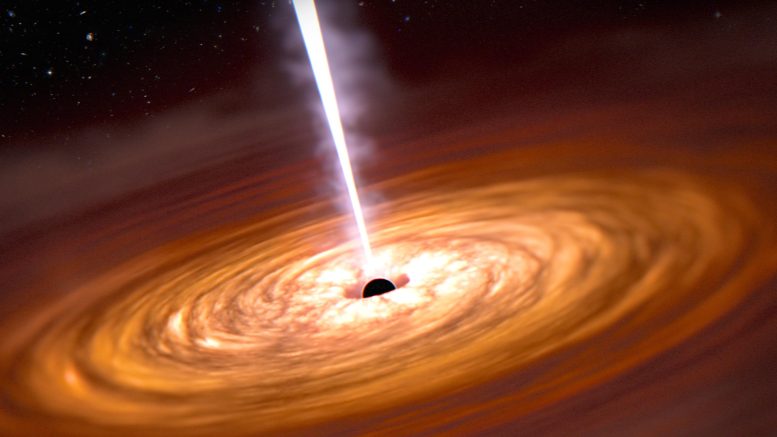
Posted on 10/21/2024 5:46:18 AM PDT by Red Badger

This image, taken by NASA’s James Webb Space Telescope, shows an ancient quasar (circled in red) with fewer than expected neighboring galaxies (bright blobs), challenging physicists’ understanding of how the first quasars and supermassive black holes formed. Credit: Christina Eilers/EIGER team
=====================================================================================
Astronomers used the James Webb Space Telescope to detect ancient lonely quasars with murky origins. They appear to have few cosmic neighbors, raising questions about how they first emerged more than 13 billion years ago.
A quasar is an incredibly bright region at the center of a galaxy, powered by a supermassive black hole. As this black hole pulls in gas and dust from its surroundings, it releases an immense amount of energy, making quasars some of the most luminous objects in the universe. Quasars have been detected from as early as a few hundred million years after the Big Bang, raising the question of how they could have become so massive and bright in such a short amount of cosmic time.
Scientists have suggested that the first quasars formed in areas of overly dense primordial matter, which likely also gave rise to smaller galaxies nearby. However, a recent MIT-led study has revealed that some of these ancient quasars seem to exist in isolation, without the dense galactic environments expected in the early universe.
Observations With the James Webb Space Telescope
The astronomers used NASA’s James Webb Space Telescope (JWST) to peer back in time, more than 13 billion years, to study the cosmic surroundings of five known ancient quasars. They found a surprising variety in their neighborhoods, or “quasar fields.” While some quasars reside in very crowded fields with more than 50 neighboring galaxies, as all models predict, the remaining quasars appear to drift in voids, with only a few stray galaxies in their vicinity.
These lonely quasars are challenging physicists’ understanding of how such luminous objects could have formed so early on in the universe, without a significant source of surrounding matter to fuel their black hole growth.

Quasars are the intensely bright centers of distant galaxies, powered by supermassive black holes that devour gas and dust, releasing massive amounts of energy. These objects are some of the most luminous in the universe, visible across billions of light-years. Credit: NASA, ESA, CSA, Joseph Olmsted (STScI)
=======================================================================================
The Isolation of Ancient Quasars
“Contrary to previous belief, we find on average, these quasars are not necessarily in those highest-density regions of the early universe. Some of them seem to be sitting in the middle of nowhere,” says Anna-Christina Eilers, assistant professor of physics at MIT. “It’s difficult to explain how these quasars could have grown so big if they appear to have nothing to feed from.”
There is a possibility that these quasars may not be as solitary as they appear, but are instead surrounded by galaxies that are heavily shrouded in dust and therefore hidden from view. Eilers and her colleagues hope to tune their observations to try and see through any such cosmic dust, in order to understand how quasars grew so big, so fast, in the early universe.
Eilers and her colleagues report their findings in a paper published on October 17 in the Astrophysical Journal. The MIT co-authors include postdocs Rohan Naidu and Minghao Yue; Robert Simcoe, the Francis Friedman Professor of Physics and director of MIT’s Kavli Institute for Astrophysics and Space Research; and collaborators from institutions including Leiden University, the University of California at Santa Barbara, ETH Zurich, and elsewhere.
Deep Space Discoveries The five newly observed quasars are among the oldest quasars observed to date. More than 13 billion years old, the objects are thought to have formed between 600 to 700 million years after the Big Bang. The supermassive black holes powering the quasars are a billion times more massive than the sun, and more than a trillion times brighter. Due to their extreme luminosity, the light from each quasar is able to travel over the age of the universe, far enough to reach JWST’s highly sensitive detectors today.
“It’s just phenomenal that we now have a telescope that can capture light from 13 billion years ago in so much detail,” Eilers says. “For the first time, JWST enabled us to look at the environment of these quasars, where they grew up, and what their neighborhood was like.”
Environmental Variations Among Quasars
The team analyzed images of the five ancient quasars taken by JWST between August 2022 and June 2023. The observations of each quasar comprised multiple “mosaic” images, or partial views of the quasar’s field, which the team effectively stitched together to produce a complete picture of each quasar’s surrounding neighborhood.
The telescope also took measurements of light in multiple wavelengths across each quasar’s field, which the team then processed to determine whether a given object in the field was light from a neighboring galaxy, and how far a galaxy is from the much more luminous central quasar.
“We found that the only difference between these five quasars is that their environments look so different,” Eilers says. “For instance, one quasar has almost 50 galaxies around it, while another has just two. And both quasars are within the same size, volume, brightness, and time of the universe. That was really surprising to see.”
Challenging the Standard Model
The disparity in quasar fields introduces a kink in the standard picture of black hole growth and galaxy formation. According to physicists’ best understanding of how the first objects in the universe emerged, a cosmic web of dark matter should have set the course. Dark matter is an as-yet-unknown form of matter that has no other interactions with its surroundings other than through gravity.
Shortly after the Big Bang, the early universe is thought to have formed filaments of dark matter that acted as a sort of gravitational road, attracting gas and dust along its tendrils. In overly dense regions of this web, matter would have accumulated to form more massive objects. And the brightest, most massive early objects, such as quasars, would have formed in the web’s highest-density regions, which would have also churned out many more, smaller galaxies.
“The cosmic web of dark matter is a solid prediction of our cosmological model of the Universe, and it can be described in detail using numerical simulations,” says co-author Elia Pizzati, a graduate student at Leiden University. “By comparing our observations to these simulations, we can determine where in the cosmic web quasars are located.”
Scientists estimate that quasars would have had to grow continuously with very high accretion rates in order to reach the extreme mass and luminosities at the times that astronomers have observed them, fewer than 1 billion years after the Big Bang.
Implications of Isolated Quasars
“The main question we’re trying to answer is, how do these billion-solar-mass black holes form at a time when the universe is still really, really young? It’s still in its infancy,” Eilers says.
The team’s findings may raise more questions than answers. The “lonely” quasars appear to live in relatively empty regions of space. If physicists’ cosmological models are correct, these barren regions signify very little dark matter, or starting material for brewing up stars and galaxies. How, then, did extremely bright and massive quasars come to be?
“Our results show that there’s still a significant piece of the puzzle missing of how these supermassive black holes grow,” Eilers says. “If there’s not enough material around for some quasars to be able to grow continuously, that means there must be some other way that they can grow, that we have yet to figure out.”
Reference:
“EIGER. VI. The Correlation Function, Host Halo Mass, and Duty Cycle of Luminous Quasars at z ≳ 6”
by Anna-Christina Eilers, Ruari Mackenzie, Elia Pizzati, Jorryt Matthee, Joseph F. Hennawi, Haowen Zhang, Rongmon Bordoloi, Daichi Kashino, Simon J. Lilly, Rohan P. Naidu, Robert A. Simcoe, Minghao Yue, Carlos S. Frenk, John C. Helly, Matthieu Schaller and Joop Schaye, 17 October 2024, The Astrophysical Journal.
DOI: 10.3847/1538-4357/ad778b
This research was supported, in part, by the European Research Council.
Webb Ping!..............
Ha sit occurred to them that these Quasars and their associate d Supermassive Black Hole ATE THE NEARBY SURROUNDING GALAXIES?..........
We were playing cosmic marbles and forgot to put them up.

But we lose election ballots right here under our noses????
I thought black holes are so dense the gravitational pull won't even let light escape. If so, how are they luminous?
As the materials spiral in, they collide and create friction when the get close to the even t horizon an disappear..................
We had a TV looked just like that!................
The Universe plays for Keepsies...................
So, we as humans can decide where the quasars are suppose to be?
Or... We have a fundamental misunderstanding about the nature of the “black hole” phenomena...
I’m going with “we don’t know what we don’t know yet”...
The Webb was my last project before I retired
It should last for another 30+ years..................Good Work!...............
Pretty much. Until we can actually see a Black Hole up close and personal we know next to nothing..........
Quasars are TV sets.
Not only that but we can date Galaxy Supermodels. Like Melania.
I don’t know beans about this stuff, although I find it fascinating. One question that comes to my mind is we evidently only see one side, what’s happening on the other side?
There should be an ‘*’ at the end of each sentence.
The footnote * would state: This may or may not be true, and is based fully on speculation that was just proven to be wrong.
Funny how they never address this question. They’ve been dodging it for years.
Disclaimer: Opinions posted on Free Republic are those of the individual posters and do not necessarily represent the opinion of Free Republic or its management. All materials posted herein are protected by copyright law and the exemption for fair use of copyrighted works.